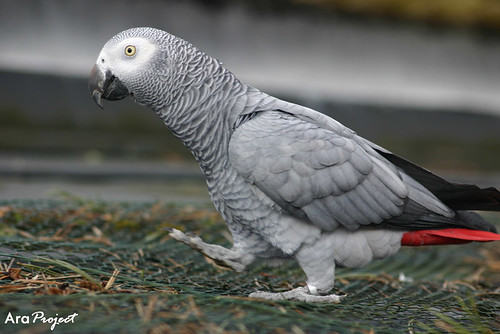Why do parrots have the ability to mimic?
 Wednesday, December 5, 2007 at 6:39
Wednesday, December 5, 2007 at 6:39  Michael Schindlinger, an assistant professor of biology at Lesley University, fields this question about our feathered friends.
Michael Schindlinger, an assistant professor of biology at Lesley University, fields this question about our feathered friends.
Parrots are not equally vocal, and many species likely imitate for different reasons. For example, African grey parrots in the wild are known to imitate other species of birds. My own observations of Amazon parrots from Mexico to Guyana to Peru revealed only imitations of each parrot's own species (and their own local dialects). When parrots are kept as pets, they learn their calls from their adoptive human social partners. Part of their appeal as pets is their ability to sing lower notes than smaller birds and so better reproduce human voices. In the wild, though, their calls may go much higher in pitch and much faster in tempo than any human tutor's voice. Regrettably, our desire for pet parrots has led to population declines of many species in their wild habitats.
But why do parrots and other birds rely on learning for vocal development instead of having each call developmentally hardwired, as with many other birds and animals? Some benefits of learning may include development of context-specific calls. Imitative vocal learning is also a reliable social display of neural functions—requiring good hearing, memory and muscle control for sound production—that may be under consideration by a potential mate or ally.
One consequence of vocal imitation is that local dialects can arise. In some cases, these regional calls may help males and females from similar areas find each other—or perhaps avoid each other. Song learning in some bird species allows territorial neighbors to know each other and helps to distinguish drifters from local territory holders. In an experimental captive population of budgerigars (small parrots from Australia, often referred to as parakeets), contact calls converged in a seeming adoption of a clan label. One study reports that budgerigars seemed to use call similarity in judging mates.
Playback studies of geographic dialects from wild parrot populations have shown that birds react more strongly to their local tongue. Maybe this is the best reason for these parrots to imitate: to better command the attention of a potential listener by producing sounds for which the listener already has a memory (or a "neural template"). The existence of a preformed perceptual template in the listener makes another parrot's imitations of him or her easier to perceive in a noisy environment. Imitations may even be directed to specific intended receivers.
Parrots, however, are not the only birds that learn by imitation. Indian mynah birds are also famed for their imitative capabilities, and in the U.S., northern mockingbirds sing repeated phrases with bits of calls appropriated from blue jays, robins, cardinals and other birds. These utterances are used in the springtime displays that inspired their common name as well as their scientific one: Mimus polyglottus.
The comparative study of parrots, and other vocally imitative animals, will help us to understand how evolution shapes neural mechanisms for complex social communication. Sadly, habitat loss and capture for the pet trade have pushed many parrot species to the brink of extinction. Parrots' great facility for learning (and the dialect variation it produces) underscores the need to save endangered species as whole populations, with their historically informative vocal traditions intact.
More to Explore
- I. M. Pepperberg. 1994.Vocal learning in grey parrots (Psittacus erithacus): Effects of social interaction, reference, and context. The Auk, 111(2):300-313
- Martella, M.B. & Bucher, E.H. (1990). Vocalizations of the monk parakeet. Bird Behav.8: 101-110.
- Wanker R, Sugama Y, Prinage S. 2005.Vocal labeling of family members in spectacled parrotlets, Forpus conspicillatus. Animal Behaviour, 70: 111-118
- Vallet E, Kreutzer M 1995. Female canaries are sexually responsive to special song phrases. Animal Behaviour 49 (6): 1603-1610
- Wright, T. F. 1996. Regional dialects in the contact call of a parrot. Proceedings of the Royal Society of London Series B, 263:867?872
- Bradbury JW, Cortopassi KA, Clemmons JR. Oct. 2001. Geographical variation in the contact calls of orange-fronted Parakeets. The Auk, 118 (4): 958-972
- P. M. Kleeman And J. D. Gilardi 2005. Geographical variation of St. Lucia parrot flight vocalizations. The Condor, 107:62?68
- Beecher, M. D., Campbell, S. E., Burt, J. M., Hill, C. E. & Nordby, J. C. 2000. Song-type matching between neighbouring song sparrows. Animal Behaviour, 59, 21?27
- Cruickshank A. J., J-P. Gautier, and C. Chappuis. 1993. Vocal mimicry in wild African Grey Parrots Psittacus erithacus. Ibis, 135:293-299
- Hile, A. G. & Striedter, G. F. 2000. Call convergence within groups of female budgerigars (Melopsittacus undulates). Ethology, 106, 1105-1114
- M. L. Moravec, G. F. Striedter & N. T. Burley. 2006. Assortative pairing based on contact call similarity in Budgerigars, Melopsittacus undulates. Ethology, 112:11 pp1108-1116
- Vehrencamp SL, Ritter AF, Keever M, Bradbury JW. 2003. Responses to playback of local vs. distant contact calls in the orange-fronted conure, Aratinga canicularis. Ethology, 109(1):37-54
- Alan B. Bond & Judy Diamond. 2004. Geographic and ontogenetic variation in the contact calls of the kea (Nestor notabilis). Behaviour, 142, 1-20

